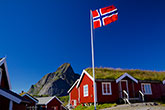Polyisocyanurate vs. cellular glass
Published by Sarah Smith,
Assistant Editor
LNG Industry,
LNG Industry Q&A with Jim Young, Cold Insulation Specialist Engineer at Johns Manville.
What are the differences between polyisocyanurate (PIR) and cellular glass insulations? Is one better for liquified natural gas (LNG) pipe insulation applications?
Polyisocyanurate (PIR) and cellular glass are the two most common materials used to insulate LNG pipes. While these two insulation materials are very different, both are successfully used in LNG applications and have long service lives. Cellular glass is exactly what it sounds like – glass, an inorganic material that contains a myriad of closed cells. PIR is an organic material that is blown to create a foam, also containing closed cells. While both products are insulating materials, they differ in many of their properties.
Before describing the specific properties of these insulations, it is important to realise that there is no single best pipe insulation material; every material has advantages and disadvantages. When selecting an insulation material, specifiers should weigh the advantages and disadvantages against their relative importance for the specific project along with the history of successful use of the material in similar applications.
The two main advantages of cellular glass as LNG pipe insulation are its water resistance and its low flammability. Since cellular glass is made entirely of closed glass cells, it offers very good resistance to both liquid water and water vapour infiltration. However, the presence of joints and the possibility of breakage present weak points in its water resistance. As a result, vapour retarders must still be used with a cellular glass insulation system, as they are with every other LNG pipe insulation system.
Being inorganic, cellular glass is also non-combustible. However, the accessory products used with cellular glass, including joint sealants and vapour retarders, are organic. This means that the completed cellular glass insulation system does not have the same combustibility performance as the cellular glass insulation alone. Further, LNG applications typically do not require the use of a non-combustible insulation. Instead, specifications usually identify only a specific flame spread index of ≤25 (measured by the ASTM E84 test). Both cellular glass and PIR meet this requirement.
The main advantages of PIR insulation are its lower (better) thermal conductivity and its significantly lower total installed cost compared to cellular glass. When compared to PIR, cellular glass has a thermal conductivity that is 25 – 65% higher (worse) than PIR. This difference in thermal conductivity directly translates into less insulation thickness needed when using PIR. This also means that PIR insulation systems have a smaller outer circumference than cellular glass systems by approximately 10 – 20%. As a result, PIR systems need less of the expensive accessory products like vapour retarders, joint sealant, and metal jacketing than cellular glass systems.
Additionally, PIR insulation both costs less per board foot than cellular glass and has lower installation costs. PIR is easier to fabricate and install, and it comes in longer pipe shells/segments (3 ft long) than cellular glass (2 ft long). This means that installers have fewer joints to address when installing PIR, so they can move more quickly, thereby reducing installation costs. Overall, PIR insulation systems require less insulation, have lower material costs, use less of the expensive accessory materials, and are easier to fabricate and install. As a result, the total installed cost savings of using PIR over cellular glass can be substantial.
The main disadvantage of PIR is that while it is closed cell, it is not as water resistant as cellular glass. Any concern with the water and water vapour resistance of PIR is eliminated by properly designing and installing the full insulation system, which is required for both PIR and cellular glass. A full insulation system includes dual vapour retarders, fully sealed joints between insulation pieces, vapour stops at key locations, and a properly installed outer protective jacket system.
The old adage, 'nothing succeeds like success,' is also true for insulation systems. For many years, both PIR and cellular glass insulation systems have been used extensively and successfully in LNG pipe insulation applications throughout the world. Both materials are excellent insulation options when they are part of a well-designed, properly installed system.
JM recognises that LNG systems have unique requirements and variables and they have developed a digital library of resources all in one spot on their website, visit their page Insulation for Cryogenic and LNG Systems. You'll find resources to help you determine which material is right for your application, including blogs that answer four more frequently asked questions about insulating LNG systems.
Written by Kim Melton, Assoc. Content Marketing Manager & Technical Writer at Johns Manville.
Read the article online at: https://www.lngindustry.com/special-reports/28052020/polyisocyanurate-vs-cellular-glass/
You might also like
Gasum opens new biogas filling station in Norway
Gasum has opened its ninth bio-LNG station in Norway, located in Førde.

